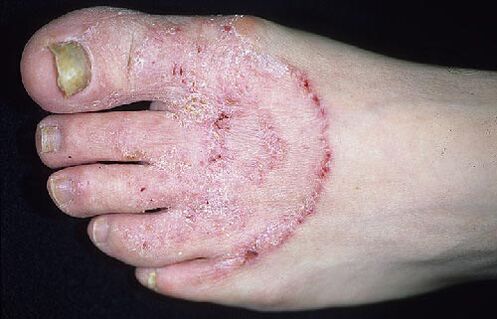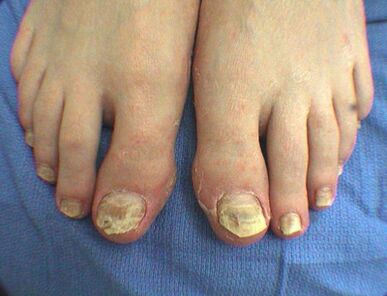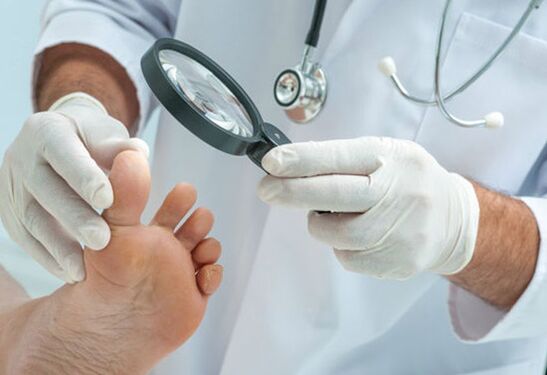Nail fungus (onychomycosis) is the most common disease in which the nails become yellow, fragile and thick, covered with cracks.In the initial stages, the symptoms of nail fungus are hardly noticeable.Treatment of the disease is difficult due to the impaired cell immunity.The disease continues slowly, without proper treatment, and can accompany the patient throughout his life.

More often, nail fungus is perceived in people with weakened immunity.Patients with diabetes, obesity, blood vessels and skin diseases are subject to disease.High sweating legs have more chances of fungal damage to the skin of the feet and the nails of the legs.
Mushrooms can come from clothes, shoes, manicure sets, carpets, flooring on the nail plates.It enters the nails through the skin's micro -fractures and the nail bed.There are many where warm and humid: souls, baths, dressing room and pool.In healthy people, the disease rarely develops.
The cause of the disease
Onychomycosis is caused by three fungal species (individually or in combination).Most cases of the disease are caused by Trichophyton Rubrum fungi.Much less frequently - the Trichophyton interdigitalle, the epidermophyton floccosum and the microsporum and the Aspergillus.
- The yeasts of the Candida albicans always parasitize on the skin and nails.Taking antibiotics, contraceptives and immunity can cause yeast infections.
- Molds often cause diseases in tropical climate countries.
- Soil mushrooms live in the soil and only cause onichomycosis.There is no transfer from person to person.
Which is a source of infection
- Family and friends illness for you can become a source of pathogens.
The mushroom is a common towel, slippers, bedding, etc.It spreads to the family by use. - The fungus in your hand can become a source of the disease of the nails and feet.
- In large numbers, the fungus lives in bathrooms, shower and pools.
- The source of infection can be the patient's clothing and shoes, manicure sets, carpets and floors.
That increases the risk of illness
- Foot skin mushroom.
- Reducing immunity.
- Family members suffer from mushroom defeat.
- Elderly.
- Diabetes.
- The presence of microtraumas and burrows.
- Increased sweating of the legs.
- Unknown and poor quality shoes.
- The habit is to go barefoot in public places.
- Accommodation and wet climate work.
- Wearing long -term artificial nails.
Which affects the development and progress of onychomycosis
- General health.
- Sensitivity to infection.
- The level of moisture and thermal background.
- Type of nail plate (nails grow slower on your fingers).

Symptoms of nail fungus
At the beginning of the disease, the usual color of the nail changes.Will be opaque.A gap in which the mushrooms itself appear between the bed and the bed.
The nail is painted in one color: whitish-gray, yellow, green and brown up to black.The yellow elongated strips are visible inside and below the nail.Spots on different shades.
The nail thickens and deformed above the affected area.The horn masses gradually increase, preventing the penetration of drugs.
At first, the increased fragility is also noted when the fungus acts on the entire nail plate, crashes and crashes.During processing, a large amount of "waste" consisting of destroyed fragments and epidermis.They are often damaged around the skin.
Onychomycosis forms
- Distalis submarine onychomycosis.
- Lateral onychomycosis.
- White surface onychomycosis.
- Proximal tray onychomycosis.
- Complete Distrophic onychomycosis.
Distal submarine and lateral onymomycosis
This form of disease is most common.Up to 90% of the cases, the reason for the trichophyton rubrum is the fungus.Infection of the nail plate begins at the open edge of the foot affected skin.First the nail bed touches.The type of damage resembles a splint or painted yellowish color.With the progression of the disease, the nail thickens and can be separated or separated from the skin.Distal submarine onykomicosis is difficult to handle.Wearing the shoes causes discomfort.
White surface onymomycosis
The second most common form of onychomycosis.In 90% of the cases, the disease is caused by the trichophyton interdigitale genus, which only affects the upper layer of the nail plate that never migrates and separates the skin.Over time, the whole surface is loosened like chalk powder.The cure occurs quickly.
Proximal tray onychomycosis
This form of onychomycosis is rare.The red trichofite spreads through the blood and the lymphatic path throughout the body.This is evidenced by the rear damage (proximal) and the detection of the pathogen in the lymph nodes of the inguinal region and in the secretion of the prostate gland.The disease is often registered with HIV infected.The defeat begins with the skin of the nail fold, which thickens.In addition, the nail plate is involved in the process, which has a white opaque color.
Complete dystrophic onychomycosis
Such a form of the disease is the result of the progress of one or type of above forms of onychomycosis.The nail plate is partially or completely destroyed.
Illnesses with similar symptoms

Of all infectious diseases, onychomycosis is found in 50% of cases.Similar symptoms are found in the following diseases:
- Eczema.
- Psoriasis.
- Reuters syndrome.
- Daria disease.
- Flat lichen.
- Norwegian crabs.
Diagnosis of nail fungus
In order to obtain information on what has caused certain changes, you need to consult a dermatologist who organizes the disease to diagnose the disease.The scraping from the affected part is sent to the laboratory to clarify the causes of the disease.
Microscopy identifies the presence of the fungus and nutrient sowing highlights clean breeding of the pathogen and determines sensitivity to antifungal drugs.
The type of infection should be determined before starting treatment. The fungus of the legs is easier to warn.Examine your feet and nails more often.Early treatment promotes rapid access to improvement, reduces the feeling of discomfort and eliminates the cosmetic effect.

























